Photos (circa winter 98-99) for this blog entry supplied by Jana Savanapridi of the Thunderfakers. Check out her music!
If I recall correctly, I first heard the term "outsider art" sometime in the early or mid-90s, while I was at Pratt Institute studying painting (and trying my damnedest to always be aware of "The Newest And Weirdest Shit"). It was likely around the time I first really studied Jean Debuffet -- he pretty much created the art-critical concept by coining the term "Art Brut" to describe artwork made by the institutionalized insane.
The term "Outsider Art" is essentially an Anglicization of "Art Brut," though in some people's minds it refers not only to the institutionalized but to anyone whose artwork exists outside of the standard studio-to-gallery-to-museum-with-a-general-knowledge-of-what's-going-on-in-art-history mode. That is to say, it's naive, and often a bit 'visionary' (much as I tend to avoid that term).
Aaaanyhow, when I first heard the term and had it explained to me, my reaction was "Oh. Like the Sanctuary of Love."
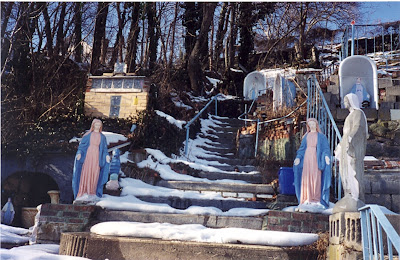
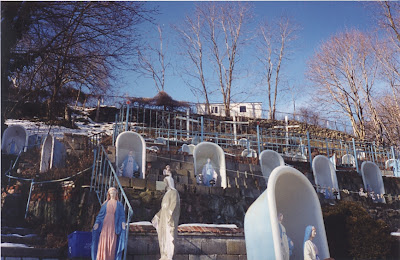
By "building," Sal meant decorating the steep incline of his building's backyard with forty-seven upturned clawfooted bathtubs, each home to a concrete statue of the Virgin Mary (he poured the concrete himself). Eventually, painted concrete seahorses and butterflies filled the yard as well. Three large wooden crosses stood near a stone wall carved with the Ten Commandments. The steps on the hill were filled with mosaics -- psalms and calls to prayer, a version of the Sea of Glass from the Book of Revelation, made of old broken glass from a nearby Thermos factory -- and eventually a lovely sign was posted on the steps leading up to the yard, reading, simply:
"WELCOME TO THE SANCTUARY OF LOVE. Your Faith Has Brought You Here."
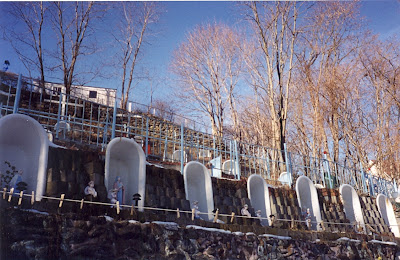
The Sanctuary had a long run as a destination for the sort of Catholic who makes visits to shrines devoted to the Virgin of Guadalupe (or any statue that weeps blood, of course). In the 90s and early '00s, it became a place for those who'd lost money at the nearby casinoes to pray for luck at gambling (or for help after losing too much money). Sal never charged admission, and let needy people stay on the property for free, though there was a bucket in the back yard that people often dropped coins into.
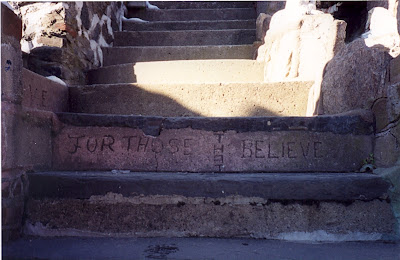
"FOR THOSE THAT BELIEVE"
Sadly, the Sanctuary might still be here had he charged admission. Here's a link to the pages from the book Weird New England, which has a brief article on the Sanctuary of Love and a scan of the New York Times article detailing the sad end of the Sanctuary of Love: the town of Norwich took the home due to some $60,000 in overdue property taxes and $40,000 in unpaid electricity bills. Sal kept living in the building for as long as possible, eventually moving into a nursing home after foreclosure proceedings began in 2000. He died of a stroke in 2004, at the age of 84, and made the national news one last time as an obituary and human-interest story. Here's another great article on Sal from CTMuseumQuest.com.
Suffice it to say, I think that Sal might be a more appropriate recipient of the label than two of the subjects I've written about recently (Emmanuel P. Gill and Genesis Breyer P-Orridge), as he had no real interest in making art, or even being recognized for his work. He was a humble, driven man who happened to make a beautiful, and meaningful, piece of art over the course of decades' worth of work.
As these photos from Flickr user Mike Z show, the site has been dismantled (everything that could be seen as valuable -- the statues, mainly -- was sold by the town of Norwich in 2002). The bathtubs and mosaics remain, and they're still beautiful, but needless to say it isn't the same without the statues of Mary, and the frail old man who loved her so much as to devote his life to building her a shrine.
More on Outsider Art soon. In the meantime, here's hoping that Eric Gearity's documentary on Sal and the Sanctuary of Love (documenting the last few years of Sal's life and his problems with the town of Norwich), gets aired and/or distributed via independent film channels.
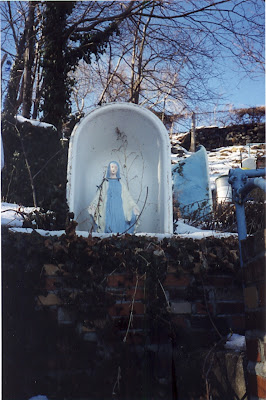





No comments:
Post a Comment